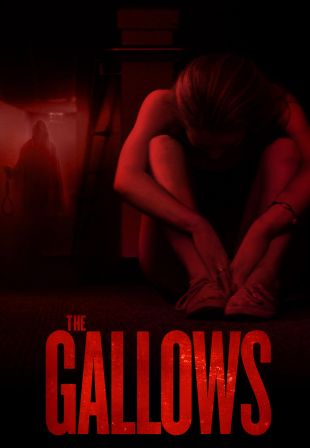
The Gallows, the latest found-footage flick from horror maven Jason Blum and his Blumhouse Productions, is a collection of just about every tired horror trope from the past decade. Chaotic camerawork, underdeveloped plot and characters, predictable jump scares, and oblivious screaming teens are the lowlights of this misfire from directing duo Travis Cluff and Chris Lofing. Blum and his crew came up miles short with this exhausting picture, which appears destined to be relegated to B-movie fodder on Netflix.
The Gallows opens up with some shaky camcorder footage of a high-school play in 1993 Nebraska. A terrible accident (or was it?) occurs, resulting in the accidental hanging of the production's lead actor, Charlie. Flash forward 20 years, and the high school has decided to restage the same production -- exact set and dialogue included. Shy ex-football player Reese (Reese Mishler) is the male lead, and he's struggling with his lines on the eve of the opening night. He also has an obvious romantic interest in the female lead, wannabe star Pfeifer (Pfeifer Brown), whose dogged determination that the show must go on is about as red a flag as you can imagine. Meanwhile, their classmate Ryan (Ryan Shoos) is inexplicably filming everything around him, including his constant badgering of "nerds" and his generally unpleasant high-school-jock shenanigans. Ryan also keeps his girlfriend Cassidy (Cassidy Gifford, daughter of Frank and Kathie Lee), a stereotypical cheerleader, close at hand.

With Reese anxious about his acting, Ryan suggests that the two of them break into the school and destroy the set of the play, which will delay the opening of the production and bail him out of his drama-class obligations. After some convincing, Reese agrees, and Cassidy demands that she partake in the mischief as well. Later that night, the trio begin trashing the stage. But they inexplicably run into Pfeifer, who apparently just roams the halls of her locked high school after sundown. From this point on, the vengeful ghost of Charlie makes its presence known as doors suddenly lock, lights flicker, and chaos ensues.
Laziness is the operative word regarding The Gallows. There are so many loose ends and unexplained plot developments that it becomes hard to focus on the scares. While Cluff and Lofing manage to produce maybe two or three moments of effective dread, they're drowned out by the amateurish acting and flimsy script. Far too much of this bomb's 81-minute runtime focuses on the unnervingly inane setup, and the film's tensest moments are pockmarked by dumbfounded teenagers looking concerned but not doing a damn thing about it. And the "twist" ending will be easily predicted by anyone who learned about foreshadowing in their fifth-grade English class.
There's a fine line to walk in the found-footage genre: The "cameraman" needs to have a personality, but he or she can't be so insufferable that it distracts from the actual film. Think back to Cloverfield, for example, where T.J. Miller found the perfect balance as the talkative yet still likeable Hud. Ryan Shoos' character in The Gallows, however, is so over-the-top annoying and bro-y that moviegoers will be counting down the seconds until he meets his demise. The filmmakers seem confused about how teenagers act in real life, and Ryan, unfortunately, represents their idea of a completely one-dimensional bully (plus there's the fact that Shoos looks about 15 years too old to be in high school). And as the chaos inside the school reaches its peak, they introduce a new point-of-view via Ryan's cell phone, making things more complicated than they need to be by dizzyingly shifting between perspectives and chroniclers.
Cluff and Lofing clearly have some maturing to do as filmmakers, and if they can break free from their reliance on horror clichés and get a proper budget and better actors, there's a chance they could create a worthwhile picture. It's possible to find artistic merit in found-footage movies, but uninventive flicks like The Gallows lower the genre to disposable nonsense -- here's hoping the trend it represents dies out sooner rather than later.
